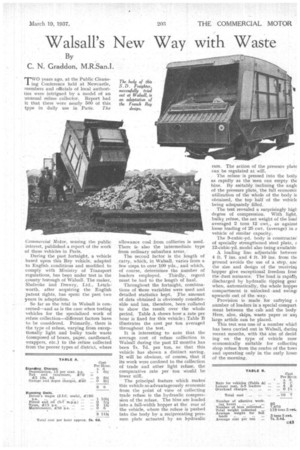Walsall's New Way with Waste
Page 93

If you've noticed an error in this article please click here to report it so we can fix it.
By
C. N. Gradclon, M.R.Sari.I.
WO years ago, at the Public Cleans big Conference held at Newcastle, members and officials of local authorities were intrigued by a model of an -unusual refuse collector. Report had it that there were nearly 500 of this
type in daily use in• Paris. The
Commercial Motor, sensing the public
• interest, published a report of the work of these vehicles in Paris.
During the past fortnight, a vehicle based upon this Rey vehicle, adapted to English conditions and modified to comply with Ministry of Transport regulations, has becn under test in the county borough of WMsall. The maker, Shelvoke and Drewry, Ltd., Letchworth, after acquiring the English patent rights, has spent the past two years in adaptation.
So far as the trial in Walsall is concerned—and as is the case when testing vehicles for the specialized work of refuse collection—different factors have to be considered. Primarily, there is the type of refuse, varying from exceptionally light and bulky trade waste (composed of boxes, paper, cardboard, wrappers, etc.) to the refuse collected from the poorer types of district, where allowance coal from collieries is used. There is . also the intermediate type -from ordinary suburban areas.
The second factor is the length of carry, which, in Walsall, varies from a few steps to over 190 yds., and which, of course, determines the number of loaders employed. • Thirdly, regard must be had to the length of haul.
Throughout the fortnight, combinations of these variables were used and detailed statistics kept. The amount of data obtained is obviously considerable and has, therefore, been collated to show the result over the whole period. Table A shows how a rate per hour is fixed for this vehicle ; Table B illustrates the cost per ton averaged throughout the test.
It is interesting to note that the average cost of refuse collection in Walsall during the past 12 months I-ias been 7s. 7a. per ton, so that this vehicle has shown a distinct saving. It will be obvious, of course, that if its work were confined to the collection of trade and other light refuse, the comparative rate per ton would be lower still,
• The principal feature which makes this vehicle so advantageously economic from the point of view of collecting trade refuse is the hydraulic compression of the refuse. The bins are loaded into a full-width hopper at the rear of
the vehicle, where the refuse is -pushed into the body by a reciprocating pres
sure plate actuated by an hydraulic ram. The action of the pressure plate can be regulated at will.
The refuse is pressed into the body as rapidly as the 'men can empty the bins. By suitably inclining the angle of the pressure plate the full economic utilization of the whole of the body is obtained, the top half of the vehicle being adequately, filled.
The test revealed a surprisingly high degree of compression. With light, bulky refuse, the net weight of the load averaged 2 tons 12 cwt., as a,gainsi loose loading of 25 cwt. (average) in a vehicle of similar capacity.
The 9-cubic-yd. body is constructer of specially strengthened steel plate, s 12-cubic-yd. model also being available A loading line adjustable betweer 4 ft. 7 ins. and 4 ft. 10 ins, from the ground avoids the use of a step, am the size and design of the receiving hopper give exceptional freedom iron' the dust nuisance. The load is rapie% discharged by hydraulic tipping gear when, automatically, the whole hoppei compartment is unlocked and swing.: upwards out of the way.
Provision is made for carrying E number of loaders in a special compart merit between the cab and the body Here, also, skips, waste paper or an large article can be placed.
This test was one of a number whicI has been carried out in Walsall, durirq recent months, with the aim of decid ing on the type of vehicle mow economically suitable for collectim shop refuse from the centre of the tows and operating only in the early hour: of the morning.
























































































































































